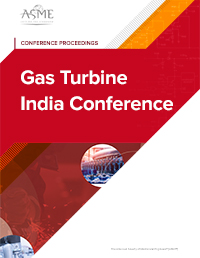A gas turbine afterburner is required to operate under severe conditions of pressure and temperature to meet the design requirements of next generation gas turbine engines. This fact, coupled with the current trends towards higher turbine discharge temperature and the requirement for satisfactory operation over extended fuel/air ratios and flight maps call for greater understanding of the internal aerodynamics for improving thrust developed by the afterburner. The present work focuses on prediction of performance of a practical afterburner for different altitude conditions and reheat strengths (i.e., fuel-air ratios) using Computational Fluid Dynamics (CFD) simulations. Combustion efficiency and thrust boost at these conditions have been predicted. The reacting flow field has been analyzed and changes suggested for improving thrust at low performance points.
Skip Nav Destination
ASME 2017 Gas Turbine India Conference
December 7–8, 2017
Bangalore, India
Conference Sponsors:
- International Gas Turbine Institute
ISBN:
978-0-7918-5850-9
PROCEEDINGS PAPER
Prediction of Gas Turbine Afterburner Performance Using CFD for Different Operating Conditions and Reheat Strength
Darshan Kattegollahalli Shivakumar,
Darshan Kattegollahalli Shivakumar
Siddaganga Institute of Technology, Tumakuru, India
Search for other works by this author on:
Ganesan Sabbani,
Ganesan Sabbani
Gas Turbine Research Establishment, Bangalore, India
Search for other works by this author on:
Gursharanjit Singh,
Gursharanjit Singh
Gas Turbine Research Establishment, Bangalore, India
Search for other works by this author on:
Purushothama Harthi Revanasiddappa
Purushothama Harthi Revanasiddappa
Siddaganga Institute of Technology, Tumakuru, India
Search for other works by this author on:
Darshan Kattegollahalli Shivakumar
Siddaganga Institute of Technology, Tumakuru, India
Ganesan Sabbani
Gas Turbine Research Establishment, Bangalore, India
Gursharanjit Singh
Gas Turbine Research Establishment, Bangalore, India
Purushothama Harthi Revanasiddappa
Siddaganga Institute of Technology, Tumakuru, India
Paper No:
GTINDIA2017-4631, V001T04A004; 9 pages
Published Online:
February 2, 2018
Citation
Kattegollahalli Shivakumar, D, Sabbani, G, Singh, G, & Harthi Revanasiddappa, P. "Prediction of Gas Turbine Afterburner Performance Using CFD for Different Operating Conditions and Reheat Strength." Proceedings of the ASME 2017 Gas Turbine India Conference. Volume 1: Compressors, Fans and Pumps; Turbines; Heat Transfer; Combustion, Fuels and Emissions. Bangalore, India. December 7–8, 2017. V001T04A004. ASME. https://doi.org/10.1115/GTINDIA2017-4631
Download citation file:
78
Views
Related Proceedings Papers
Related Articles
Time-Accurate Predictions for a Fully Cooled High-Pressure Turbine Stage—Part II: Methodology for Quantifications of Prediction Quality
J. Turbomach (July,2009)
Development and Application of an Eight-Step Global Mechanism for CFD and CRN Simulations of Lean-Premixed Combustors
J. Eng. Gas Turbines Power (March,2008)
The Ultrahigh Efficiency Gas Turbine Engine With Stator Internal
Combustion
J. Eng. Gas Turbines Power (February,2016)
Related Chapters
Outlook
Closed-Cycle Gas Turbines: Operating Experience and Future Potential
Performance Testing of Combined Cycle Power Plant
Handbook for Cogeneration and Combined Cycle Power Plants, Second Edition
Combined Cycle Power Plant
Energy and Power Generation Handbook: Established and Emerging Technologies












